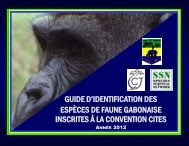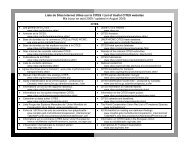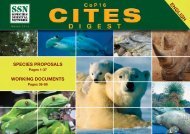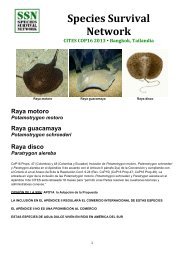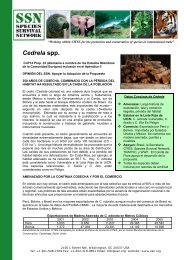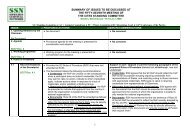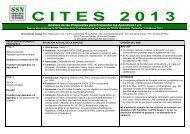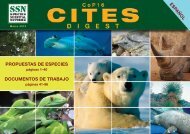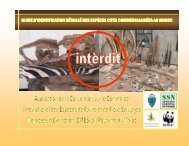SSN's Comments on South Africa's Regulations on Threatened and ...
SSN's Comments on South Africa's Regulations on Threatened and ...
SSN's Comments on South Africa's Regulations on Threatened and ...
You also want an ePaper? Increase the reach of your titles
YUMPU automatically turns print PDFs into web optimized ePapers that Google loves.
Clause 28(2) states that an issuing authority must refuse an applicati<strong>on</strong> for a permit for the captive<br />
breeding or keeping of specimens of a listed large predator species if the purpose of such breeding is<br />
for hunting or the sale or supply of such animals to other pers<strong>on</strong>s for hunting purposes. Unfortunately,<br />
this does not address the final dispositi<strong>on</strong> of the animal, <strong>on</strong>ly that the purpose of the breeding <strong>and</strong><br />
keeping. This clause should make it clear that the breeder or keeper who receives a permit will be held<br />
resp<strong>on</strong>sible if the animal c<strong>on</strong>cerned is used for hunting purposes (for example, if a listed large predator<br />
that is bred for the purpose of public display later is used for hunting, the breeder should be held<br />
resp<strong>on</strong>sible as should all other links in the chain).<br />
Recommended new clause: “An issuing authority must refuse an applicati<strong>on</strong> for a permit for the<br />
captive breeding or keeping of specimens of a listed large predator species if such breeding involves<br />
commercial transacti<strong>on</strong>s or encouragement of commercial ventures or trade.” This is c<strong>on</strong>sistent with<br />
the IUCN statement <strong>on</strong> captive breeding.<br />
Applicati<strong>on</strong>s for hunting of captive bred or kept listed predators<br />
This key clause (29) of the regulati<strong>on</strong>s does not refer to scientific instituti<strong>on</strong>s (defined, in part, as zoos<br />
<strong>and</strong> aquaria). By not including registered scientific instituti<strong>on</strong>s, this means that permits may be granted<br />
to hunt a large predator bred or kept at the instituti<strong>on</strong>, <strong>and</strong> to sell <strong>and</strong> export a large predator for hunting<br />
purposes. We str<strong>on</strong>gly recommend that scientific instituti<strong>on</strong>s be included in Clause 29.<br />
Clause 29(2) explicitly allows for the hunting of listed large predators from captive-breeding<br />
operati<strong>on</strong>s, rehabilitati<strong>on</strong> facilities or sanctuaries as l<strong>on</strong>g as they have been living in an “extensive<br />
wildlife system”—which can include being fenced in, being supplied with food, water <strong>and</strong> medical<br />
treatment—<strong>and</strong> the animal has been “fending for itself in the wild” for at least two years. Wild<br />
mammals that have been kept in captivity for any period of time, particularly those bred in captivity,<br />
are unlikely to behave like animals that did not have that experience. The related Draft Nati<strong>on</strong>al Norms<br />
<strong>and</strong> St<strong>and</strong>ards for the Regulati<strong>on</strong> of the Hunting Industry in <strong>South</strong> Africa call for hunters to exhibit<br />
ethical c<strong>on</strong>duct <strong>and</strong> to provide the animal with a “fair chance” of evading the hunter. We fail to see<br />
how hunting an animal that has been kept or bred in captivity, <strong>and</strong> that has had a closer than normal<br />
(even benevolent) relati<strong>on</strong>ship, with humans is ethical or provides a “fair chance” to escape.<br />
Furthermore, we do not see how it will be possible for an applicant to know that an animal “has been<br />
fending for itself in the wild for at least two years”. In fact, nothing in these regulati<strong>on</strong>s prevents the<br />
breeding, keeping <strong>and</strong> hunting of listed large predators <strong>on</strong> “extensive wildlife systems”. Finally, this<br />
text is inc<strong>on</strong>sistent with the definiti<strong>on</strong> of “sanctuary” which states that a sanctuary is to provide a<br />
“permanent captive home”. We str<strong>on</strong>gly recommend that Clause 21(2) be deleted in its entirety.<br />
Part 7. Register <strong>and</strong> Reporting<br />
Register of applicati<strong>on</strong>s <strong>and</strong> decisi<strong>on</strong>s<br />
Clause 34 states that issuing authorities must keep a register of all applicati<strong>on</strong>s received <strong>and</strong> permits<br />
issued by that authority. We recommend that this register be made available to the public, preferably <strong>on</strong><br />
a website.<br />
Chapter 3: Registrati<strong>on</strong> of captive breeding operati<strong>on</strong>s, nurseries, sanctuaries <strong>and</strong> rehabilitati<strong>on</strong><br />
facilities<br />
11



